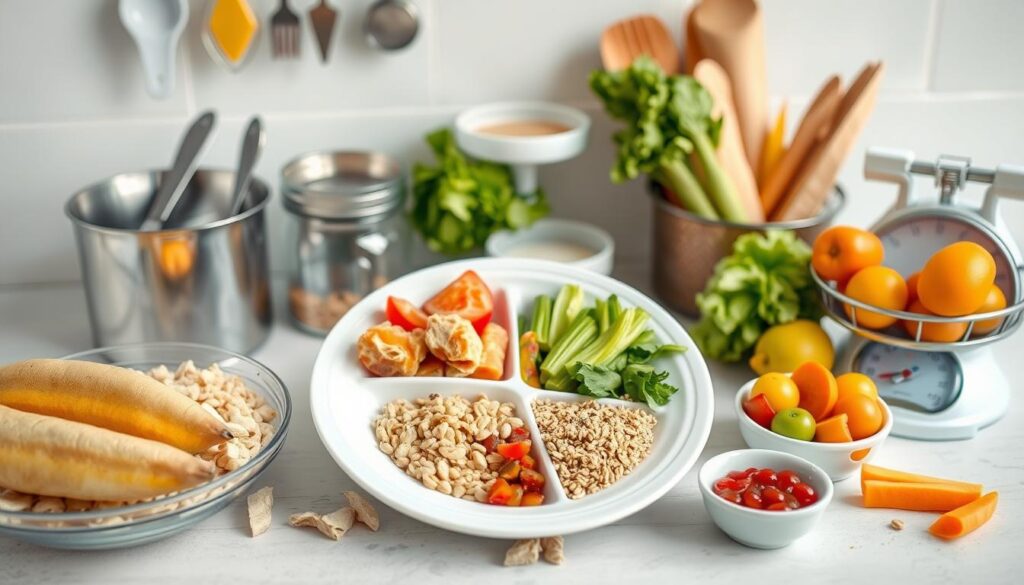The Best Fluffy Pancakes recipe you will fall in love with. Full of tips and tricks to help you make the best pancakes.

True wellness is more than just following diet trends. It’s about a holistic approach that nourishes your body, mind, and spirit. This guide will show you how to build a sustainable, nutrition-focused lifestyle. You’ll learn to thrive by understanding nutritional wellness and creating your meal plan.
Key Takeaways
- Explore the key nutrients your body needs daily for optimal function.
- Learn how to leverage macronutrients and micronutrients for greater health benefits.
- Discover strategies for creating a sustainable meal planning approach.
- Understand the importance of portion control and smart techniques for weight management.
- Integrate plant-based foods into your daily menu for enhanced nutrition.
- Cultivate mindful eating habits to support better digestion and overall wellbeing.
- Combine exercise and clean eating habits for maximum results.
Understanding the Foundations of Nutritional Wellness
Keeping a healthy diet is key for your well-being. Your body needs certain nutrients every day. Knowing what these nutrients do helps you make better food choices.
Key Nutrients Your Body Needs Daily
Your body needs macronutrients like proteins, carbs, and fats. It also needs micronutrients like vitamins and minerals. Eating a variety of nutrient-rich foods helps meet these needs.
The Role of Macronutrients in Your Diet
Macronutrients give your body energy. Proteins help fix tissues, carbs keep you going, and fats support hormones and cells. Getting the right mix is important for a healthy balanced diet.
Essential Micronutrients for Optimal Health
Micronutrients are also crucial. Vitamins A, C, and B-complex, and minerals like calcium and iron, boost your immune system and bone health. Eating a variety of nutrient-rich foods is key.
Knowing what nutrients your body needs helps you eat well. A diet full of nutrient-dense foods is the basis for a healthy life.
Creating Your Sustainable Meal Planning Strategy
Meal planning is a great way to reach your health and wellness goals. It helps you eat well and live sustainably. We’ll show you how to plan meals that are good for you and the planet.
Embrace the Power of Meal Prepping
Meal prepping is key to sustainable meal planning. Spend some time each week planning, preparing, and cooking meals ahead. It saves time, cuts down on waste, and keeps healthy food ready.
- Find simple recipes that make lots of food at once.
- Use reusable containers for your meals.
- Try ingredients that can be used in many dishes.
Embrace Seasonal and Local Produce
Choosing seasonal and local foods is important for living sustainably. It helps your community and cuts down on transportation pollution. Look at what’s in season and use those fresh ingredients in your meals.
“Eating seasonally and locally is a simple way to reduce your carbon footprint and enjoy the freshest, most nutrient-dense foods.” – Sustainability Expert, Jane Doe
Minimize Food Waste
Reducing food waste is vital for sustainable meal planning. Be smart about what you buy, how much you use, and how you store food. This way, you waste less money and resources.
- Plan meals using what you already have.
- Get creative with leftovers, like making soups or smoothies.
- Compost food scraps to help the environment.
Adopting sustainable meal planning can greatly benefit your health, wallet, and the planet. By following these tips, you’ll enjoy a diet that’s good for you and the earth.
Healthy Balanced Diet and Lifestyle: A Complete Guide
Getting a healthy, balanced diet is key for feeling your best. This guide will show you how to make balanced meals, time your eating right, and add lots of nutritious foods to your day.
Building Balanced Plates for Every Meal
Making well-rounded meals is the first step to a healthy diet. Your plates should have lean proteins, complex carbs, healthy fats, and lots of fruits and veggies. This mix helps meet all your nutritional needs.
Timing Your Meals for Maximum Benefits
When you eat matters as much as what you eat. Eating at the same times every day helps keep your metabolism and energy steady. Eat every 3-4 hours, and watch your portion sizes to avoid eating too much.
Incorporating Variety in Your Diet
- Try a variety of colorful fruits and veggies for lots of vitamins and minerals.
- Try different whole grains like quinoa, brown rice, and whole wheat bread.
- Include a range of lean proteins, like fish, poultry, legumes, and plant-based options.
- Add new healthy fats, such as avocado, nuts, and olive oil, to keep things interesting.
By following these tips, you’ll be on your way to better nutrition and wellness.
Smart Portion Control Techniques for Weight Management
Getting a healthy balanced diet is not just about what you eat. It’s also about how much you eat. Portion control is key for managing weight and staying healthy. By learning smart portion control, you can give your body what it needs without eating too much.
Using visual cues is a good way to know the right serving sizes. For example, a palm-sized portion of protein, a fist-sized portion of carbs, and a cupped hand’s worth of healthy fats make balanced meals. Also, eating from smaller plates and bowls can make you feel full with less food.
- Practice portion control by using your hand as a guide: a palm-sized portion of protein, a fist-sized portion of carbohydrates, and a cupped hand’s worth of healthy fats.
- Opt for smaller plates and bowls to create the illusion of a fuller plate with less food.
- Slow down your eating pace and savor each bite to allow your body to register feelings of fullness.
- Drink a glass of water before and during meals to help you feel more satisfied.
- Pay attention to hunger and fullness cues, and stop eating when you feel comfortably full, not overly stuffed.
By adding these portion control tips to your healthy balanced diet, you can manage your weight well. This supports your health and well-being.

“The key to portion control is being mindful of how much you’re eating, not just what you’re eating.”
Integrating Plant-Based Foods into Your Daily Menu
Starting a plant-based diet can change your health and help the planet. Adding more plant-based foods to your meals opens up a world of health benefits and new recipes.
Benefits of Plant-Based Protein Sources
Plant-based proteins like legumes, nuts, and seeds are full of good stuff. They have amino acids, fiber, vitamins, and minerals. Eating these can help you stay healthy, control blood sugar, and lower disease risk.
Creative Ways to Add More Vegetables
Vegetables are key to a clean eating lifestyle, packed with nutrients. Here are some ways to eat more veggies:
- Try new and seasonal veggies to mix up your meals.
- Add veggies to breakfast, like spinach in omelets or avocado on toast.
- Make smoothies with greens and fruits for a healthy start.
- Roast veggies with herbs and spices for tasty sides or main dishes.
- Use veggie noodles instead of regular pasta.
| Plant-Based Protein Sources | Nutritional Benefits |
|---|---|
| Lentils | High in fiber, folate, and iron |
| Quinoa | A complete protein with all essential amino acids |
| Almonds | Rich in healthy fats, vitamin E, and magnesium |
| Chickpeas | Excellent source of plant-based protein and fiber |
By choosing plant-based foods and creative veggie dishes, you nourish your body and support wellness. Dive into the world of plant-based foods and clean eating to make your meals healthier and tastier.
Mindful Eating Practices for Better Digestion
Embracing mindful eating can change how you view food and improve digestion. It helps you listen to your body’s hunger and fullness signals. This leads to a more nourishing and satisfying eating experience.
Key to mindful eating is being present in the moment. When you eat, take deep breaths and use your senses. Notice the colors, aromas, and textures of the food. Chew slowly, savoring each bite and letting your body enjoy the flavors and sensations.
- Avoid distractions like TV, work, or scrolling on your phone during meals. This keeps you focused and present.
- Listen to your body’s hunger and fullness signals. Stop eating when you feel comfortably satisfied, not too full.
- Try mindful eating exercises, like expressing gratitude for your meal or focusing on the first few bites.
Mindful eating habits can lead to a healthier relationship with food and better wellness and digestion. Remember, becoming mindful is a personal journey. Be patient with yourself and enjoy the process of tuning into your body’s needs.
“The act of eating should be an attentive, appreciative, and enjoyable experience. Mindful eating can transform your relationship with food and your body.”
Combining Exercise with Clean Eating Habits
To reach your health and fitness goals, you need to balance exercise and clean eating. By matching your diet with your workout plan, you can get the most out of your fitness journey. This includes eating right before and after your workouts.
Syncing Nutrition with Your Workout Schedule
It’s important to eat at the right times to get the most from your workouts. Here are some tips to help you match your diet with your exercise:
- Eat a meal with carbs, proteins, and fats 1-2 hours before working out. This gives you energy that lasts.
- Choose simple carbs like fruit or sports drinks during your workout. They help keep your energy up.
- After working out, eat a mix of proteins and carbs within 30 minutes. This starts your recovery.
Pre and Post-Exercise Nutrition Guide
Good nutrition before and after your workouts can really help your fitness. Here are some tips:
| Pre-Workout | Post-Workout |
|---|---|
|
|
By matching your fitness and clean eating habits, you can get the most out of your wellness plan. This helps you reach your health and fitness goals faster.
Lifestyle Habits That Support Nutritional Success
Optimal wellness is more than just diet. It’s about living a holistic lifestyle that supports healthy eating. Let’s look at key lifestyle factors for nutritional success.
Prioritize Quality Sleep
Quality sleep is vital for your body’s best function. Aim for 7-9 hours each night. This allows your body to rest, repair, and regulate hormones that affect appetite and metabolism.
Manage Stress Effectively
Chronic stress harms your health and sustainable living efforts. Add stress-reducing activities like meditation, yoga, or hobbies to your day.
Stay Hydrated
- Drink lots of water all day to stay hydrated.
- Hydration supports digestion and nutrient absorption.
Embrace Movement and Exercise
Regular exercise boosts your energy, mood, and well-being. Choose activities you love, like running, strength training, or sports.
“Sustainable living and wellness go hand-in-hand. By adopting these lifestyle habits, you’re setting the foundation for long-term nutritional success.”
Your wellness journey is holistic. By adding these lifestyle habits, you’ll support your nutritional efforts.

Conclusion
In this guide, you learned how to keep a healthy diet and lifestyle. You now know the basics of nutrition and how to plan meals well. You have the tools to start your journey to better health.
By using the tips we shared, like making balanced plates and eating at the right times, you can eat better every day. Small steps towards a healthier diet can really improve your life.
Start eating mindfully, exercise, and live a healthy lifestyle. Your health is worth it, and the benefits are huge. Make slow, lasting changes, and you’ll reach your wellness goals.


